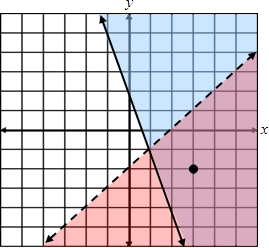SYSTEMS OF INEQUALITIES
|
Unit Overview
In this unit, you are going to expand on the idea of systems of equations and learn how to graph linear inequalities and systems of linear inequalities. Systems of linear inequalities can be used to establish ranges of possibilities for real-world situations, such as budgeting and cost.
Linear Inequalities
A linear inequality is like a linear equation, except the equal sign is replaced with an inequality sign, and the solution to the inequality is a region of the coordinate plane.
| A linear equation would be in the form of y = |
| A linear inequality would look like y ≥ |
| Notice that the equal sign from the top equation was replaced by an inequality sign in the bottom equation. |
A linear inequality can have one of the following signs:
< “less than” |
> “greater than” |
≤ “less than or equal to” |
≤ “greater than or equal to” |
To graph a linear inequality, follow similar steps to solving linear equations:
| 1) Solve the inequality for y and make sure it is in the slope-intercept form (y = mx + b) . The difference is, there will be an inequality sign instead of an equals sign. |
| 2) Plot the y-intercept (0, b). |
| 3) Use the slope ratio |
| 4) This line is the boundary line that divides the coordinate plane into two regions or half planes. |
| 5) Draw a dashed line through the points if the inequality is less than (<) or greater than (>) ( OR Draw a solid line if the inequality sign is less than or equal (≤) or great than or equal (≥) ( |
6) Shade a region of the graph that satisfies the inequality. |
Let’s practice a couple of examples.
Example #1: Graph x + y < –3
|
Example #2: Graph –2x + 3y ≥ –6
|
Stop! Go to Questions #1-9 about this section, then return to continue on to the next section.
Graphing Systems of Linear Inequalities
Now that you have learned how to graph a linear inequality, we will expand on this and graph a system of linear inequalities. A system of linear inequalities is like a system of equations except that the solution to a system of inequalities is a region on the coordinate plane that represents the intersection of both inequalities.
To solve a system of inequalities:
| 1) Graph each inequality on a coordinate plane (one at a time but on the same plane). |
| 2) Shade the solution to each inequality. |
| 3) Determine where the shading of both inequalities intersects. |
Example: Graph the solution to the system of inequalities shown below.
Solve for y.
The two inequalities are shown on separate planes so you can see the solutions easier. When you solve a system of inequalities you will do so on one plane as shown below:
Thus, we can see that the correct region is shaded because the point we selected satisfies both inequalities. |
||||||||||||||||||||||||||||||||||||||||||||||||
Stop! Go to Questions #10-18 about this section, then return to continue on to the next section.
Applications of Systems of Equations
When using systems of inequalities in the real world, this is often referred to as Linear Programming. The concept is the same as above. Write and graph each inequality (these are sometimes referred to as constraints) and the solutions to the problem will lie within the shaded region.
Interestingly – when seeking a maximum or minimum value –this will always be one of the vertices of the shaded polygon within the bounded areas. Let’s try an application:
|
Determine which of the following scenarios would be correct based on the graph of the inequalities and shows that Maleigha met her goal.
![]() Maleigha should sell 3 cheese pizzas and 7 pepperoni pizzas.
Maleigha should sell 3 cheese pizzas and 7 pepperoni pizzas.
No, this ordered pair (3, 7) is outside of the shaded region.
"Click here" to check the answer.
"Click here" to view the graph.
![]() Maleigha should sell 10 cheese pizzas and 7 pepperoni pizzas.
Maleigha should sell 10 cheese pizzas and 7 pepperoni pizzas.
Yes, this ordered pair (10, 7) is in the shaded region.
"Click here" to check the answer.
"Click here" to view the graph.
![]() Maleigha should sell 5 cheese pizzas and 11 pepperoni pizzas.
Maleigha should sell 5 cheese pizzas and 11 pepperoni pizzas.
Yes, this ordered pair (5, 11) is on the edge of the shaded region.
"Click here" to check the answer.
"Click here" to view the graph.
Stop! Go to Questions #19-32 to complete this unit.














